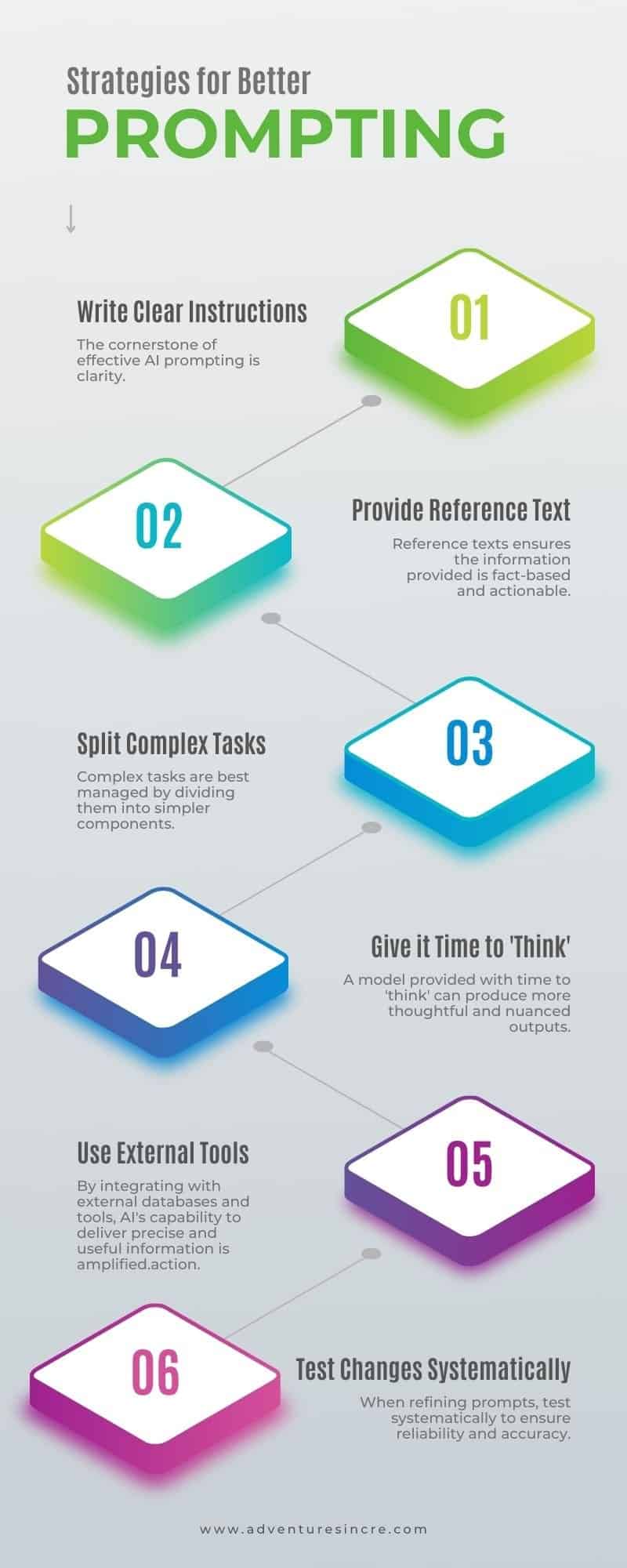Strategies for Better AI Prompting
In the commercial real estate industry where precision and foresight are essential, artificial intelligence – and generative AI in particular – has emerged as a game-changer. AI, through language models like ChatGPT and Google Bard, can sift through data, generate reports, and even simulate negotiation scenarios. They can also help us save enormous amounts of time with day-to-day tasks.
However, the power of these tools is not just in their algorithms but in how we, as users, engage with them. Our daily interactions at A.CRE with such models have made it abundantly clear: the caliber of the prompts we provide directly influences the quality of the output we receive. It’s a concept as fundamental in AI as location is in real estate.
OpenAI recently released a guide on strategies for better prompting that resonated with us here at A.CRE. The content of the guide has helped us create better prompts for the tasks we have LLMs perform, and so we thought we’d share it with the broader A.CRE community. So, let’s dive into a few strategies for better prompting.
#1 Strategies for Better Prompting – Write Clear Instructions
The cornerstone of effective AI prompting is clarity. We don’t expect our analysts to read between the lines, and the same goes for AI. Specify what you’re looking for with precision. For instance, when asking for a market analysis, don’t just ask for “market conditions”; specify the type of property, location, and key metrics you’re interested in.
Tactics & Example:
- Clearly state the intended length: “Provide a 200-word overview…”
- Use bullet points or numbers to separate sections.
- Example: Instead of “Tell me about the market,” prompt with, “Summarize current cap rates for multifamily properties in the Atlanta metro area.”
#2 Strategies for Better Prompting – Provide Reference Text
A robust AI output is akin to a well-researched market report. By grounding AI in reference texts, we mimic the due diligence process, ensuring the information provided is fact-based and actionable.
Tactics & Example:
Cite sources: “According to the latest CBRE report…”
Use data points to prevent AI from generating assumptions.
Example: “Using data from Yardi Matrix, compare Class A office vacancy rates in Q1 2021 vs. Q1 2022 in Dallas.”
#3 Strategies for Better Prompting – Split Complex Tasks
Complex tasks are best managed by dividing them into simpler components, much like a phased development project. This ensures a focused and thorough analysis, leading to actionable intelligence.
Tactics & Example:
- Break down tasks into sequential steps.
- For an underwriting model, prompt step-by-step: “First, calculate the net operating income…”
#4 Strategies for Better Prompting – Give the Model Time to ‘Think’
A strategic pause before a big decision is a hallmark of seasoned professionals. Similarly, a model provided with time to ‘think’ can produce more thoughtful and nuanced outputs.
Tactics & Example:
- Encourage comprehensive reasoning: “Explain the rationale for…”
- For lease negotiations, prompt: “Outline a negotiation strategy for a tenant with a five-year lease term seeking concessions.”
#5 Strategies for Better Prompting – Use External Tools
In commercial real estate, we use a variety of tools for analysis and forecasting. AI can do the same. By integrating with external databases and tools, AI’s capability to deliver precise and useful information is amplified.
Tactics & Example:
- Integrate tools such as GIS for location analytics.
- When evaluating a site, prompt: “Assess the demographic trends within a 3-mile radius using Census Bureau data.”
#6 Strategies for Better Prompting – Test Changes Systematically
You wouldn’t make an acquisition based on a single data point. Similarly, when refining prompts, test systematically to ensure reliability and accuracy.
Tactics & Example:
- Benchmark AI outputs against known datasets.
- After adjusting a prompt, verify: “Compare the revised income assumptions to historical averages for similar assets.”
Conclusion – Strategies for Better Prompting
Just as a well-executed deal in CRE hinges on the meticulousness of the groundwork laid, the success of our interactions with AI depends on the quality of our prompts. These strategies are your blueprint for constructing prompts that yield results with the precision of a finely tuned financial model. For every commercial real estate professional venturing into AI, let these strategies guide your prompts to mine the full potential of these extraordinary tools.
Let’s embrace the precision in our prompts with the same vigor we apply to our investments. The returns, in terms of insights and efficiency, can be just as significant.

Summary of OpenAI’s six strategies for getting better results guide (Source)









